Assembly
AMS is being built in bits and pieces all over the world. The silicon tracker is in Switzerland, the transition radiation detector in Germany, the magnet in Great Britain. The gas system is in New Jersey, the Unique Support Structure is at a Lockheed Martin plant, the electronics are in Taiwan.All of the parts will come together in Zurich, Switzerland, in 2004. They will be assembled one bit at a time, starting with the magnet (which must be moored and encased in the USS), and with detectors and cabling being added on top. This process must be planned with exquisite care - everything on the inside must be assembled before anything on the outside. When everything is together and working, we will turn it on and start detecting particles.
Beam tests
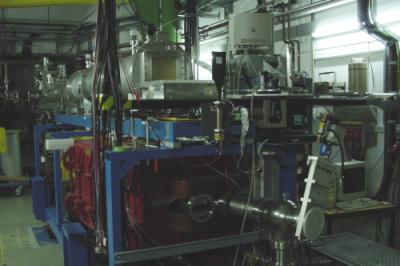 AMS is of course very complicated, and no one can really anticipate every detail of how it will respond to particles. Our computer models can predict the physical reactions of detector materials (ionization, voltages, currents, photons); how those reactions will be registered by the electronics; how the digital data will be assembled by the computer software. Lots of numerical nuances are lost in all of these simulations. However, if we do not master the details of these detector responses, we'll never be able to interpret our particle data.
AMS is of course very complicated, and no one can really anticipate every detail of how it will respond to particles. Our computer models can predict the physical reactions of detector materials (ionization, voltages, currents, photons); how those reactions will be registered by the electronics; how the digital data will be assembled by the computer software. Lots of numerical nuances are lost in all of these simulations. However, if we do not master the details of these detector responses, we'll never be able to interpret our particle data.
The only way to really trust your detector is to test it. AMS will be laid on its side in particle accelerator beams from CERN's Super Proton Synchrotron, and GSI's ion accelerators. The detector, working as a coherent whole just like it will in space, will attempt to detect all of these particles. We look at the data and figure out what is going right and what is wrong. If we stick AMS in a proton beam, and it thinks it's seeing helium nuclei, then we know that our calibrations are off. If you shoot 50 GeV/c^2 protons and the detector thinks they are at 40 GeV/c^2, then your magnet/tracker is making mistakes. (Those are exaggerated examples, of course; what we will actually do, is fine-tune a handful of numerical parameters that describe the detector. These parameters go back into the computer simulations, and we adjust the simulations until they correctly describe the beam data.)
Kennedy Space Center
 Once AMS is working in the test beam, we are almost ready for launch. A chartered 747 (although probably not a Super Guppy like this picture) will carry AMS from Switzerland to Florida. There, we have to convince NASA that we are ready to go to ISS.
Once AMS is working in the test beam, we are almost ready for launch. A chartered 747 (although probably not a Super Guppy like this picture) will carry AMS from Switzerland to Florida. There, we have to convince NASA that we are ready to go to ISS.
We will run through a rigorous series of communication tests, making sure that AMS can send data through ISS as designed. We will test our operations procedures, making sure that we can turn AMS's systems on and off and whatever via the ISS telemetry.
We will go through a few mechanical fit tests, making sure that AMS will latch securely into the Shuttle and onto ISS. We will dangle from a giant crane, which will confirm that we weigh less than 14,800 lbs. We will sit in a thermal vacuum chamber, perhaps, to demonstrate our response to the space environment. 
After all of these checkouts (which take a few months), AMS is ready to go. We will fill up our gas system with xenon and CO2, fill the magnet tank with liquid helium. A special crane or lift will stick AMS into the Shuttle cargo bay. The Shuttle drives over to the launch pad atop the "crawler". At the launch pad, the Shuttle's cargo bay doors are opened into a special clean room, where technicians make final adjustments and AMS's magnet team will keep topping off the helium tank.
AMS will remain plugged in and online until about 80 hours before launch, while our team keeps an eye on temperatures, pressures, and general health. Just before the 80 hour cutoff, we will top off the helium tank one more time, detach our helium hoses and electrical cables, and say good-bye. The shuttle bay doors will be closed soon and AMS will wait in the dark until launch.
Launch
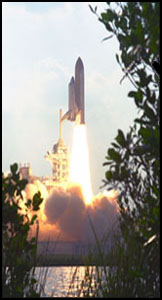 A shuttle launch is a well-practiced and well-engineered procedure, but it is hair raising nonetheless. The STS vehicle (two boosters, a fuel tank, and the orbiter itself) starts off bolted to the launch pad, leaning back a little bit under the weight of the Orbiter. At the end of the countdown, the Orbiter's main engines ignite. This causes the whole STS to rock forwards slightly. If the engine firing is successful, the solid rocket boosters are ignited - they can't be turned off once they are on! - and the tiedown bolts are released. The shuttle climbs off of the pad, and is largely out of the atmosphere 1 minute later.
A shuttle launch is a well-practiced and well-engineered procedure, but it is hair raising nonetheless. The STS vehicle (two boosters, a fuel tank, and the orbiter itself) starts off bolted to the launch pad, leaning back a little bit under the weight of the Orbiter. At the end of the countdown, the Orbiter's main engines ignite. This causes the whole STS to rock forwards slightly. If the engine firing is successful, the solid rocket boosters are ignited - they can't be turned off once they are on! - and the tiedown bolts are released. The shuttle climbs off of the pad, and is largely out of the atmosphere 1 minute later.
The launch puts 3 "G's" of force on the Shuttle and all of its contents; under this force, AMS's whole structure will bend downwards by a few centimeters. In addition, there are 150 decibels of noise, a really unbelieveable shaking that can easily twist off an unsecured bolt or two. (It's OK, AMS will have no unsecured bolts!) Meanwhile, we are rushing upwards at, eventually, ten kilometers per second.
After only one minute, AMS will be above most of the atmosphere - an important detail, since all of the air inside of AMS has to be able to escape quickly. (So, as much as we'd like to, we cannot wrap AMS in airtight, light-tight plastic - we have to leave big paths for the air to escape). After three minutes, the engines begin cutting out, the vibration ceases, and we're basically in orbit.
Getting to the S3 Truss
AMS has to get from the Shuttle bay all the way out to the starboard truss. The Shuttle arm will pick AMS up out of the bay and bring it near the station. In midair, so to speak, the Space Station's own "Canada arm" will grab us. The Canada arm will roll out to the truss on its little railway, and plop AMS down on its mount point. All of the electrical and mechanical connections will be made by the amazingly-dextrous arm.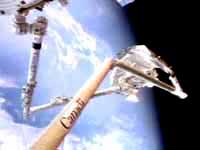
Once we are plugged in, we want to get up and running as soon as possible. We will turn AMS on and make sure all of the computers, etc., are OK, and perhaps even record a few cosmic rays. And then we turn on the magnet!
Talking to AMS
AMS data is analyzed in the onboard computer. Some of it will be beamed to the ground via high-rate radio connections to Spain, New Mexico, and other NASA communications centers.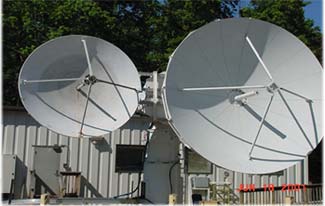 (At the same time, a small rack of hard drives, the ACOP, will store the data right on ISS. Every once in a while, the crew will bring back these hard drives for us.) The data that comes to the ground is buffered briefly at Marshall Space Flight Center in Alabama; from there it is transmitted to CERN for permanent storage and analysis. Meanwhile, information about AMS's health is transmitted to a control center at MIT. The MIT control center will be able to send commands to AMS (with NASA's approval), to do things like open valves, adjust voltages, upload new software, and so on.
(At the same time, a small rack of hard drives, the ACOP, will store the data right on ISS. Every once in a while, the crew will bring back these hard drives for us.) The data that comes to the ground is buffered briefly at Marshall Space Flight Center in Alabama; from there it is transmitted to CERN for permanent storage and analysis. Meanwhile, information about AMS's health is transmitted to a control center at MIT. The MIT control center will be able to send commands to AMS (with NASA's approval), to do things like open valves, adjust voltages, upload new software, and so on.
Three years in space
Three years is a long time! Every day, two pounds of liquid helium will boil off from the magnet, cooling it. Every day, seven liters of Xenon-CO2 will leak out of the TRD - the gas system will mix fresh gas, in a procedure involving a dozen or so valve operations, and refill the TRD. Every day, AMS will orbit the Earth 16 times, passing in and out of full sunlight on most orbits. 24 hours a day, every day, a little diaphragm pump will move gas through the TRD; another will move liquid CO2 through the tracker cooling system; several cryocoolers will mechanically "pump" heat out of the magnet.Every day, every component gets a day older. :) Some of them will break. Some of them, perhaps, will short out when a high-energy nucleus hits them in the wrong way. Some things may be destroyed by micro-meteorites. We'll do our best to avoid it, but perhaps a card or a cable could jiggle loose during launch, or something. Read the next section (The Space Environment) to see some of the things that may go wrong.
The Hostile Space Environment
Space is a hostile, unfriendly place. There are all sorts of difficulties that AMS has to deal with on-orbit.- In low-Earth orbit, it's not quite a vacuum. There are a lot of ionized oxygen atoms zipping around (similar to the "free radicals" that you hear about from nutritionists, only worse). Free radicals are the most corrosive things imaginable; they'll eat through a millimeter of plastic in a few months. AMS can't have exposed plastic.
- In low-Earth orbit, it's still a better vacuum than the best experimental chambers on Earth. There will be experiments on/outside ISS that depend on this vacuum - AMS is not permitted to contaminate it. You're familiar with "new car" smell or "new carpet" smell? That smell is due to organic solvents which evporate from all plastics. All plastics on AMS - exposed or not - have to be pretreated so that they don't "outgas" these solvents. For all plastics, this is difficult; for some plastics this is impossible. We have to design with this in mind.
- AMS has to radiate all of the heat it generates. Not only are there 2000 watts of power heating up our computers, but sometimes the sun is shining on us continuously for hours! So AMS's thermal control system is designed to efficiently whisk heat out to AMS's surfaces, and glow it away into the 3 K coldness of space. Unfortunately, sometimes AMS is getting very little sunlight. Since we can't turn off the thermal system, AMS is in danger of getting very cold. We have to strike a careful balance - build the radiators efficient enough that we do not die of heat in the sun, but also not so efficient so we do not get to cold in the dark!!
- Humans have only been flying into space for about 50 years, but we've already left a noticeable trash pile behind.
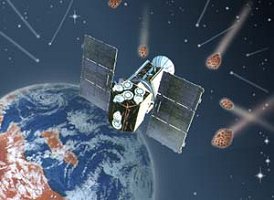 Billions of pieces of junk - bits of abandoned satellites, rocket casings, etc. - are whizzing around up there at thousands of meters per second. In addition, there are natural "micrometeorites" passing by at tens of thousands of meters per second. We have to consider what will happen if we get hit. It may seem like there's not a lot you can do, right? One thing we can do is to try to "localize" damage. If a micrometeorite hits one part of the gas-filled Transition Radiation Detector, valves will close to seal off that part, and the rest of the detector will still work.
Billions of pieces of junk - bits of abandoned satellites, rocket casings, etc. - are whizzing around up there at thousands of meters per second. In addition, there are natural "micrometeorites" passing by at tens of thousands of meters per second. We have to consider what will happen if we get hit. It may seem like there's not a lot you can do, right? One thing we can do is to try to "localize" damage. If a micrometeorite hits one part of the gas-filled Transition Radiation Detector, valves will close to seal off that part, and the rest of the detector will still work.
- We're going into space to measure high-energy particles, yet these same particles can hurt us. First of all, spending three years in space gives AMS a fairly large dose of radiation. It's not deadly (the astronauts, for example, are OK with it) but it can sort of age semiconductors and lower their performance. A more dangerous radiation effect is the "single event effect". A high energy nucleus really creates a lot of ionization when passing through material; sometimes there is enough ionization to "flip" a bit in memory, or even to momentarily short-circuit a transistor. We've had to pre-certify that our electronics are not subsceptible to this sort of thing - basically by putting it in a particle beam, pounding it with 10 years' worth of radiation, and seeing how well it works. You would be surprised how quickly (and how catastrophically) most transistors die in a particle beam!
Sitting shift
While AMS is in space for three years, our team of scientists will be on the ground. 24 hours a day, seven days a week, one of us will be watching! This is a longstanding tradition for particle physicsists; everyone on the experiment, from the new graduate students right up to Prof. Ting, will probably have to spend a few eight-hour shifts at the control center. The shifter's job is to watch the incoming data - maybe make a little plot of the proton spectrum occasionally, for example - and see if anything looks unusual. He or she will also watch various temperatures, pressures, and voltages - if anything serious goes wrong, there is an established procedure for what to do. If something not-so-serious goes wrong, the shifter will be able to page the experts directly.
Anyway, everyone on the collaboration can look forward to some long (hopefully boring) nights and weekends and early mornings, watching AMS work!
Bringing AMS home
After AMS runs out of helium to cool the magnet, the Space Shuttle will bring it back to Earth. Certainly it will be a bit worse for wear! The electronics will be a bit radiation-damaged, some phototubes will have failed, a few tubes in the TRD will have sparked and died. Rather than repairing it immediately, we will stick AMS back into the test beams, and recalibrate it all over again. The new testbeam data will help us understand how AMS has aged, and we will use this knowledge to do more accurate analyses of our data. The data analysis will or course take many years.What happens to AMS afterwards? Well, perhaps we may repair it, improve it, and send it back into space! Perhaps we will dismantle it, and its components will become spare parts, classroom aids, and museum exhibits at labs around the world. (This is what happened to the AMS prototype - MIT undergraduates are using its time-of-flight components in their junior physics lab!)
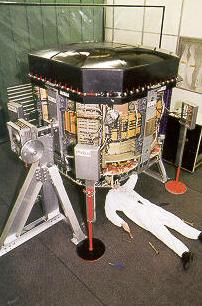 AMS would be a much easier experiment on the ground. On the ground, we could build a magnet in a cheap aluminum vacuum case, plugged into an off-the-shelf cryo system for cooling. On the ground, we'd have a rack of desktop computers sitting next to AMS, spouting data directly to CERN via the internet. On the ground, we'd point ordinary fans and air-conditioners at our computers to keep them cool. On the ground, we would plug in a xenon bottle every few months to refill the gas system. On the ground, malfunctioning parts could be swapped out by two grad students armed with crescent wrenches. All of the engineering is easier on the ground.
AMS would be a much easier experiment on the ground. On the ground, we could build a magnet in a cheap aluminum vacuum case, plugged into an off-the-shelf cryo system for cooling. On the ground, we'd have a rack of desktop computers sitting next to AMS, spouting data directly to CERN via the internet. On the ground, we'd point ordinary fans and air-conditioners at our computers to keep them cool. On the ground, we would plug in a xenon bottle every few months to refill the gas system. On the ground, malfunctioning parts could be swapped out by two grad students armed with crescent wrenches. All of the engineering is easier on the ground.